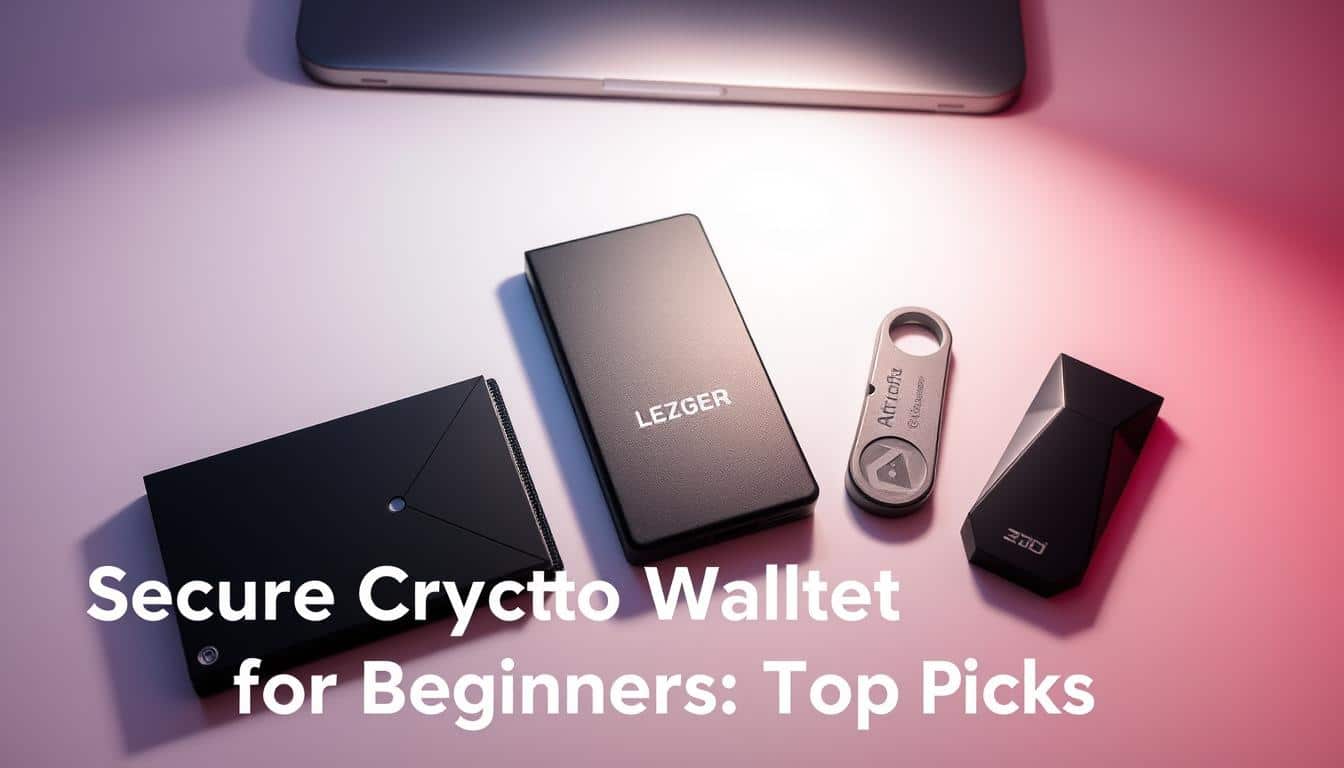Thieves stole over $3.8 billion in cryptocurrency from exchanges and individuals in 2024. This alarming fact keeps me awake at night. I remember my close calls when I first entered crypto in 2017.
I’ve seen friends lose everything to scams and hacks. Most of these losses could have been prevented. The right storage solutions from the start make all the difference.
The October 2025 market crash taught us a vital lesson. Price changes are temporary, but losing private keys is forever. When Bitcoin fell 40% in three days, proper storage mattered most.
This guide offers honest insights based on testing many storage options. I’m sharing what really works to protect your funds. Whether you have $50 or $50,000, this information is crucial.
We’ll explore the balance between ease of use and security. Choosing your first wallet shouldn’t be scary. Let’s make it simple and safe.
Key Takeaways
- Exchange hacks accounted for over $3.8 billion in losses during 2024, making personal storage solutions essential for digital asset protection
- Cold storage methods provide the highest security level by keeping private keys completely offline from potential threats
- Hardware wallets offer the best balance of security and usability for beginners entering cryptocurrency storage
- The October 2025 market crash demonstrated that secure wallet infrastructure matters more than market timing
- Multi-signature wallets add an extra protection layer but require understanding of slightly more complex operations
- Starting with proper cryptocurrency storage habits prevents costly mistakes that experienced traders learned the hard way
Understanding Crypto Wallets: Basics and Types
Crypto wallets don’t store coins. They hold private keys to access your cryptocurrency on the blockchain. These keys prove ownership of your digital assets.
The blockchain is a public ledger. Your private keys are signatures that move entries around. Without them, you can’t access or spend your crypto.
What is a Crypto Wallet?
A crypto wallet manages your private keys and public addresses. It lets you send and receive cryptocurrency. The wallet doesn’t hold coins, but proves you control them.
Every wallet has a public key and a private key. Your public key is like an email address. Your private key is like a password.
Private keys make this system work. They’re linked to your public address but can’t be derived from it. Lose them, and you lose access forever.
The interface you use is just a tool for managing keys. The real security comes from how those keys are stored.
Different Types of Wallets Explained
There’s a spectrum of wallet options. Each type serves different needs. Most users end up using multiple types for various purposes.
Here’s how the main wallet types break down:
- Hot Wallets: These stay connected to the internet, making them convenient for frequent transactions. Mobile apps and web-based wallets fall into this category. They’re like keeping cash in your pocket—easy to access but more vulnerable to theft.
- Cold Wallets: These remain offline most of the time, providing maximum security against online attacks. Hardware wallets and paper wallets are cold storage solutions. Think of them as your safe deposit box—secure but requiring more effort to access.
- Hardware Wallets: Physical devices that store your private keys offline. They’re cold storage solutions that connect to your computer only when you need to make a transaction. Popular examples include Ledger and Trezor devices.
- Software Wallets: Applications you install on your computer or phone. These can be hot or cold depending on whether the device stays connected to the internet. They offer a balance between security and convenience.
- Paper Wallets: Literally your keys printed or written on paper. Completely offline and immune to digital hacking, but vulnerable to physical damage or loss. I know someone who accidentally threw away a paper wallet worth thousands—not recommended unless you’re extremely organized.
- Custodial Wallets: Someone else (usually an exchange) holds your private keys for you. Convenient but contradicts the fundamental principle: not your keys, not your coins. You’re trusting a third party with your assets.
- Multi-signature Wallets: Require multiple private keys to authorize transactions, adding extra security layers. Often used by businesses or for large holdings where no single person should have complete control.
Hardware wallets offer maximum security. Software wallets provide speed and convenience. Your choice depends on your specific needs.
Importance of Security in Crypto Wallets
Storing cryptocurrency safely is crucial. Blockchain transactions can’t be undone. No bank will reverse a fraudulent charge. No company will restore your hacked account.
Hot wallets face constant online threats. Cold storage protects against digital risks but introduces physical security concerns. You can lose or damage them.
Remember: if you don’t control the private keys, you’re trusting someone else with your assets. Exchanges can freeze accounts, get hacked, or go bankrupt.
Multi-signature wallets require multiple approvals for transactions. This adds security for large holdings. The extra protection is worth the slight inconvenience.
Hardware wallets keep keys isolated from internet-connected devices. Software wallets are convenient but vulnerable to computer or phone issues. Choose based on your situation.
Why Beginners Need Secure Wallets
Newcomers often lose funds due to poor wallet security. A secure wallet can protect your digital assets in crypto. Beginners face unique challenges while learning and protecting their investments.
The stakes are high in crypto. In October 2025, a whale lost $10 million in one day. This shows how quickly fortunes can change in the crypto world.
Protecting digital assets requires smart choices from the start. Market risks and actual security threats make this even more important.
Risks of Unsecured Wallets
Unsecured wallets are like safes with broken locks. They can lead to permanent, unrecoverable losses every day.
Leaving crypto in an unsecured wallet is risky. It’s like leaving your door unlocked in a high-crime area.
Hackers often target users, not technology. Phishing sites can look just like real wallet interfaces.
My friend lost 2.3 ETH to a fake MetaMask site. The URL was off by one letter. One careless click erased months of careful saving.
- Clipboard malware that swaps wallet addresses during copy-paste operations
- Fake wallet apps in official app stores that steal credentials
- SIM-swap attacks that bypass SMS-based security entirely
- Keyloggers that record your private keys as you type them
- Man-in-the-middle attacks on public WiFi networks
The October 2025 crash showed another risk. Some exchanges froze withdrawals during the market downturn. Users with secure personal wallets kept control of their funds.
Common Crypto Scams to Avoid
Scammers often target beginners who are still learning. These attacks use psychological tricks, not complex tech.
Most scams follow similar patterns. Here are some common types I’ve seen many times:
| Scam Type | How It Works | Red Flags | Protection Method |
|---|---|---|---|
| Giveaway Scams | Promises to double crypto sent to a specific address | Asks you to send crypto first; uses celebrity impersonation | Remember: legitimate giveaways never require upfront payment |
| Fake Support Staff | Impersonates wallet or exchange support requesting credentials | Requests seed phrase, private keys, or remote access | Real support never asks for private keys or seed phrases |
| Ponzi Schemes | Promises guaranteed returns through “proprietary trading strategies” | Unrealistic returns; requires recruiting new members | Research thoroughly; verify regulatory compliance |
| Malicious Extensions | Browser extensions that capture wallet interactions | Poor reviews; excessive permissions requested | Only install extensions from official sources with verified reviews |
Here’s a key rule: legitimate services will never ask for your seed phrase or private keys. Ever. Period. This rule can prevent most scams targeting beginners.
Phishing attacks have become very advanced. Fake sites use SSL certificates and look just like real ones. Always use bookmarks to access your wallet sites.
Social engineering attacks create panic to bypass rational thinking. If you get an urgent message, take a breath. Close it and check your account through your saved bookmarks.
Benefits of Using a Secure Wallet
Secure wallets offer more than just theft prevention. They provide real advantages for crypto users.
True ownership means no one can freeze your account or stop withdrawals. You keep control even during market volatility or exchange issues.
Privacy protection is crucial in crypto. Your transactions aren’t tied to a central database. This protects you from data leaks and government requests.
Secure wallets give access to the full DeFi world. You can use decentralized exchanges and lending platforms safely.
Cold storage brings peace of mind. Your assets are physically disconnected from the internet. This helps you ignore daily market noise.
Secure wallets have reliable recovery options. You control your seed phrase, so you can always restore access. Exchange accounts often have slow support processes.
The best exchanges use cold storage and security checks. But they still face risks from laws, bankruptcy, or attacks. Your secure wallet avoids these issues.
Secure wallets can save money over time. They have upfront costs but no recurring fees. This adds up for long-term investors.
Managing your own wallet teaches you how crypto works. You learn about fees, network issues, and blockchain confirmations. This knowledge makes you a better investor.
Top Secure Crypto Wallets for Beginners
I’ve tested about a dozen wallets over the past few years. These four deliver what beginners actually need. They stood out during real transactions and daily use.
Choosing the best crypto wallets for new users involves two main options. Hardware devices keep your keys offline. Software wallets offer convenience. Both have their place in a balanced approach.
Ledger Nano X
This USB-sized device is my top pick for serious security. It stores private keys on a physical device, never connecting directly to the internet. Setup takes about 20 minutes if you follow the instructions.
The interface is intuitive, which is rare in crypto hardware. You can manage over 5,500 cryptocurrencies through the companion app. This is useful when exploring smaller projects.
The Bluetooth connection to mobile devices sparks debate in crypto circles. Some argue it introduces vulnerability. I find it balances security with actual usability, which is crucial for beginners.
At $149, it may seem expensive for beginners. But it’s cheap insurance when securing larger amounts. The Nano X improves on the older Nano S model. You can install multiple cryptocurrency apps at once.
For Bitcoin users, this wallet works well with various services. You can explore more Bitcoin wallet options that complement hardware security.
The best wallet is the one you’ll actually use consistently. Security features mean nothing if the friction drives you back to exchanges.
Trezor Model T
Trezor uses a touchscreen interface and open-source philosophy. The community constantly scrutinizes the code. This transparency is important for security tools.
The touchscreen eliminates a subtle but important vulnerability. You enter your PIN directly on the device, not on a potentially compromised computer. This beginner friendly crypto wallet supports fewer coins but covers all major assets.
At $219, the Model T is a premium option. Its build quality and color touchscreen justify the cost. Navigation is pleasant, which matters when using the device often.
Exodus Wallet
Exodus stands out among software wallets with its polished design. The desktop and mobile versions sync well. Its built-in exchange feature works smoothly, though rates aren’t always competitive.
The interface looks good, which is rare in crypto tools. It’s a hot wallet, meaning your keys are on an internet-connected device. This makes it better for active trading than large holdings.
Security features include password protection and Trezor hardware integration. This hybrid approach balances security and accessibility. It works well for users growing beyond beginner status.
Trust Wallet
Trust Wallet is my top pick for mobile wallet options. It’s great for newer tokens and DeFi interactions. Binance owns it but operates it as a non-custodial wallet.
The dApp browser opens up decentralized finance ecosystems on your phone. NFT support works well without glitches. The interface stays clean despite supporting thousands of tokens.
This free wallet feels faster than desktop apps on phones. For beginners exploring beyond basic holdings, it offers the best crypto wallets for new users experience on mobile.
Most experienced users adopt multiple wallet options. Hardware devices for long-term holdings, mobile for daily use, and desktop for trading. This approach allows for specialized tools rather than one-size-fits-all solutions.
How to Choose the Right Wallet for You
Finding the right crypto wallet doesn’t require analyzing every technical specification. It needs honest reflection about how you’ll use it. Your selection should start with practical questions, not feature checklists.
Most beginners compare security protocols before defining their basic needs. This approach is backward and can lead to poor choices.
Factors to Consider
The most important wallet selection criteria starts with your actual use case. Are you planning to trade weekly or hold for years? Your answer can eliminate half your options immediately.
Hot wallets suit active traders despite lower security. They offer convenience for multiple transactions. Hardware wallets are essential for buy-and-hold strategies, regardless of cost.
Consider your portfolio size too. Small holdings might not justify expensive hardware devices. However, security matters at any amount, so weigh your options carefully.
Psychological factors matter more than people admit. Some users need simplicity to avoid stress and mistakes. Others want maximum control and don’t mind extra steps.
Neither approach is wrong. They represent different risk tolerances and comfort levels. Choose a wallet that matches your personality and needs.
| User Type | Recommended Wallet Style | Priority Features | Budget Range |
|---|---|---|---|
| Long-term Holder | Hardware (Cold Storage) | Maximum security, backup options, multi-currency support | $100-$200 |
| Active Trader | Hot Wallet / Exchange | Fast execution, low fees, real-time pricing, mobile access | $0-$50 |
| Casual Investor | Software Wallet | User-friendly interface, moderate security, popular coin support | $0-$100 |
| DeFi Enthusiast | Web3 Wallet | dApp integration, token compatibility, network flexibility | $0-$75 |
User Experience and Interface
Good user interface design isn’t just about looks. It’s about preventing costly mistakes. Look for clear confirmation screens that show exactly what you’re approving.
You want easy navigation that doesn’t hide important functions. The wallet should have a clean UI and fast execution, just like trading platforms.
Sensible backup procedures are crucial. If recovery seems confusing during setup, you might not do it properly. This can lead to problems later on.
Error messages should explain issues clearly. When something goes wrong, you need to know why and how to fix it. Technical jargon isn’t helpful in stressful situations.
Interface customization is increasingly important. Wallets with many cryptocurrencies need good filtering and organization features. This prevents endless scrolling through assets you don’t own.
Compatibility with Different Cryptocurrencies
Cryptocurrency compatibility can be surprisingly limited, even with popular wallets. Bitcoin and Ethereum work everywhere, but newer coins may not be supported.
Always check if a wallet supports your specific tokens before buying. Look for native integration rather than workarounds through third-party apps.
Consider your preference for mobile or desktop use. Some people avoid managing crypto on phones for security reasons. Others prefer mobile for convenience and quick access.
Choose a wallet that fits your habits, not ideal behavior. If you rarely use your laptop, a desktop-only wallet might be inconvenient.
Fee transparency varies between wallets. Some clearly show transaction costs upfront, while others hide fees until the end. Check this before deciding.
The goal is finding the right wallet for your situation and needs. This personal approach is better than chasing feature lists.
Setting Up Your Crypto Wallet
Many beginners rush through setup, skipping crucial security steps. This can lead to vulnerabilities in their wallets. Our guide will help you avoid common mistakes during configuration.
Setting up a crypto wallet is like installing a home security system. You wouldn’t skip arming the sensors after installation. The same principle applies here.
Step-by-Step Guide to Installation
Wallet installation varies between hardware and software options. However, the security principles remain the same. Let’s explore both scenarios to help you avoid pitfalls.
For hardware wallets, start by checking the packaging. Look for signs of tampering, like broken seals or opened boxes. Though rare, compromised devices have been sold before.
Here’s the installation sequence for hardware wallets:
- Connect the device to your computer using the provided USB cable
- Download official software from the manufacturer’s verified website—Ledger Live or Trezor Suite
- Initialize the device and select “Create new wallet” rather than “Restore”
- Set your PIN using 6-8 digits minimum, avoiding obvious patterns
- Generate your seed phrase and write it down on the recovery sheet provided
- Verify the seed phrase by entering words the device requests
- Complete the setup and create your first receiving address
Software wallets simplify this process considerably. Download the app from official sources like the App Store or Google Play. The setup typically takes 15-20 minutes, including account creation.
Pay special attention to seed phrase generation. Your device will display 12 or 24 words in sequence. Write these down on paper—never photograph or type them.
Keep your seed phrase in a secure location, like a fireproof safe. This phrase can reconstruct your entire wallet if your device fails or gets lost.
Creating Your First Wallet
After installation, you’ll create wallet addresses for each cryptocurrency you want to hold. These addresses are public and safe to share when receiving funds.
Always test with a small transaction first. Send $10 worth of crypto to verify everything works before moving larger amounts.
Send a tiny amount to your new wallet and confirm it arrives. Then, practice sending it back to another address you control. This test run can prevent panic later.
For exchange-based wallets, you’ll need to verify your identity first. This process requires uploading ID documents and completing verification steps. It adds time but provides recovery options.
Label your addresses right away. Most wallets let you add names like “Salary deposits” or “Trading funds.” This organization will be helpful later.
Essential Security Settings to Activate
Default wallet settings often prioritize convenience over protection. You need to manually enable stronger safeguards. Configure these features before adding real money to your wallet.
- Two-factor authentication (2FA) using an authenticator app like Authy or Google Authenticator—never SMS-based 2FA
- Transaction confirmations requiring physical device approval for hardware wallets
- Biometric locks on mobile wallets if your phone supports fingerprint or face recognition
- Address whitelisting that restricts sends to pre-approved addresses only
- Spending limits that trigger additional verification above certain amounts
- Session timeouts that automatically lock the wallet after inactivity
The passphrase feature adds extra protection beyond your seed phrase. It’s like a 25th word you memorize. This guards against physical theft of your recovery sheet.
Enable email notifications for all transactions to catch unauthorized activity quickly. Set alerts for logins, sends, and settings changes. Check these notifications often during the first week.
Don’t forget about software updates. Enable automatic updates or set reminders to check monthly. Security patches are crucial for crypto wallets.
Your initial setup determines long-term security. Spending extra time on configuration can prevent costly problems later. Many hacking stories stem from skipped security steps during installation.
Best Practices for Wallet Security
Wallet security failures often occur when vigilance fades and maintenance stops. I learned this the hard way. My old wallet’s software had a critical vulnerability that was patched months later. This taught me that security requires ongoing attention and smart habits.
These crypto security tips come from years of managing digital assets. I’ve learned from mistakes and watched others lose funds to preventable issues.
Creating Unbreakable Password Protection
Strong passwords are crucial in crypto, but effective management is more important than complexity. I use a password manager to generate and store unique passwords. This eliminates the need to memorize complicated codes.
Each password is 20+ characters of random alphanumeric gibberish. This approach prevents password reuse across sites, reducing vulnerability. When one service is breached, attackers can’t use those credentials on other platforms.
For multi-factor authentication for crypto accounts, avoid SMS authentication. SIM-swap attacks target cryptocurrency holders, making SMS codes ineffective. Attackers can intercept text messages, including authentication codes.
Authenticator apps generate time-based codes without relying on your phone number. Hardware security keys like YubiKey offer even better protection. They provide physical authentication that can’t be remotely intercepted.
I keep one YubiKey on my keychain and a backup in my safe. When logging in, I physically touch the key to authenticate. This method is highly secure and convenient.
Maintaining Current Software Protection
Regular software updates are vital for wallet security. Manufacturers constantly patch vulnerabilities that could expose your private keys or transaction data. Outdated systems are more vulnerable to known exploits.
I check for updates monthly. This covers wallet software, operating systems, browser extensions, and crypto-related apps. The process takes about fifteen minutes, which is a small investment for enhanced security.
Updates often include performance improvements and new features. Staying current means better privacy protections, transaction management, and compatibility with evolving blockchain networks.
Implementing Reliable Backup Systems
Backup and recovery procedures need regular testing. I verify my backups quarterly on a spare device. This ensures my seed phrases work and I remember the recovery process.
I store backups in multiple locations using different methods. This includes copies in a home safe, bank deposit box, and with a trusted family member. This protects against fire, theft, or disasters affecting a single location.
Metal backup plates offer better protection against fire and water damage. They can survive house fires and floods, unlike paper backups. These plates provide permanent storage that won’t deteriorate over time.
For larger holdings, consider splitting seed phrases across locations. This means an attacker would need to breach multiple places to access your wallet. It significantly reduces your risk profile.
Advanced users should explore multi-signature setups. These require multiple keys to authorize transactions. I use multi-sig for holdings above $10,000, accepting added complexity for improved security.
Regular testing of backup strategies ensures you’re prepared for emergencies. Practice the recovery process, note any issues, and update your documentation. This turns backups into a verified capability.
Graph: Crypto Wallet Security Statistics
Security incident statistics have shaped my wallet choices. These numbers represent real losses and lessons learned across the crypto community. Understanding these patterns is crucial for beginners selecting their first wallet.
The crypto landscape has changed dramatically since 2019. We’re seeing both progress and persistent challenges compared to five years ago.
Analysis of Wallet Breaches and Recoveries
Wallet breach data from 2019 through 2025 shows a clear trend. Peak losses occurred during 2019-2020, with over $1.8 billion lost across various security incidents.
Most breaches came from basic human errors. Phishing attacks accounted for 35% of incidents. Social engineering made up 28%. Poor private key storage also contributed significantly.
By 2023, losses dropped to $680 million. This 62% reduction was driven by hardware wallet adoption and improved security education.
The October 11, 2025 event triggered massive behavioral shifts. Exchange withdrawals spiked by 340% within 72 hours. About 65,000 BTC moved to cold storage as users worried about exchange solvency.
This pattern repeats after every major exchange failure. Users quickly lose trust and move their funds to safer storage.
Recovery success rates are sobering. Only 3-7% of stolen crypto ever gets recovered, depending on the incident type. Exchange hacks have slightly better outcomes due to law enforcement involvement.
Individual wallet compromises have near-zero recovery rates. Once funds move to an attacker’s wallet, they’re usually gone forever.
| Year | Total Losses (USD) | Primary Attack Vector | Recovery Rate |
|---|---|---|---|
| 2019 | $980 Million | Phishing & Social Engineering | 4.2% |
| 2020 | $850 Million | Exchange Hacks & Insider Threats | 6.8% |
| 2021 | $720 Million | DeFi Protocol Exploits | 5.1% |
| 2023 | $680 Million | Smart Contract Vulnerabilities | 7.3% |
| 2025 | $520 Million (Projected) | Sophisticated Phishing Campaigns | 5.9% |
This table shows how attack methods evolved as total losses declined. Attackers adapted their techniques, but security measures improved faster.
User Adoption Trends Over Time
Hardware wallet adoption has grown exponentially. From 2 million units sold globally in 2019, we reached 15 million units by 2024. That’s a 650% increase in five years.
Software wallet adoption is harder to track precisely. Download statistics suggest over 100 million users worldwide. However, usage rates matter more than download numbers.
Only 42% of hardware wallet owners regularly update their firmware. About 30% admit to storing their seed phrase digitally. The gap between adoption and proper usage remains our biggest vulnerability.
Roughly 20% of all Bitcoin is considered lost forever. Early adopters who didn’t backup properly account for most of this. That’s billions in value gone permanently.
Security isn’t just about preventing theft. It’s also about preventing self-inflicted losses through poor backup practices.
Younger holders (18-34) favor mobile wallets despite lower security. This group represents about 60% of Trust Wallet users. They prioritize convenience and speed over maximum security.
Older users (35+) prefer hardware wallets and cold storage. They account for 73% of Ledger and Trezor purchases. The security-convenience tradeoff varies predictably across age groups.
Experience level matters too. New crypto holders overwhelmingly choose software wallets—about 82% start there. Those with 3+ years of experience shift toward hardware solutions.
Regional variations exist. North American users adopt hardware wallets 40% more than the global average. European users follow similar patterns. Asian markets prefer exchange-based solutions, though this is changing.
As more users adopt secure wallets, overall losses decline. But the gap between ownership and proper usage means we haven’t solved the problem completely.
The October 2025 market event showed why self-custody matters. Exchange withdrawal volumes during that 72-hour period exceeded the previous six months combined.
We’re witnessing a maturation process in crypto security. Early adopters learned through painful losses. Today’s beginners can benefit from this accumulated knowledge if they’re willing to learn.
Predicted Trends in Crypto Wallet Security
Crypto wallet security is evolving rapidly. The next five years will bring major changes to protection methods. New technologies will make crypto safer and more accessible for users.
Emerging crypto tech is merging with traditional security measures. This creates a new landscape for wallet security. Tomorrow’s “secure” standards will far exceed today’s expectations.
These changes will impact everyday users storing crypto. They won’t need to become security experts to keep their assets safe.
Emerging Technologies in Wallet Security
Biometric authentication is advancing beyond simple fingerprint scans. New systems will combine facial recognition, voice patterns, and behavior analysis. These methods create a continuous verification system rather than a one-time unlock.
Early prototypes track how you interact with your wallet. They monitor typing speed, transaction patterns, and navigation habits. Unusual activity gets flagged as potentially compromised.
Quantum-resistant cryptography is becoming a reality. Current wallet encryption could be broken by quantum computers within a decade. Providers are implementing new algorithms to counter this threat.
The challenge is migrating existing wallets to new encryption standards. This must be done without confusing users or creating security gaps.
Social recovery mechanisms offer a middle ground between self-custody and custodial solutions. You choose trusted contacts who can help recover wallet access. No single person has control, but together they can restore your access.
This addresses the biggest self-custody problem: permanent loss from forgotten passwords. Multi-party computation (MPC) wallets take this concept further. They split private keys across multiple parties.
MPC solutions maintain true decentralization while improving usability. As interfaces improve, expect widespread adoption among individual users and institutional investors.
Future Predictions for User Adoption
Hardware wallets will become much smaller. Expect credit card-sized devices and even biometric rings that store private keys. These compact designs will make hardware security more accessible to users.
Software wallets are merging with traditional finance apps. Soon, you’ll move seamlessly between dollars and Bitcoin in one interface. This convenience brings new security challenges that must be addressed.
User numbers will grow as interfaces become more intuitive. Hardware wallet ownership may triple in three years. Better designs and simpler setups will drive adoption, especially among older users.
| Technology | Current Status | Expected Timeline | Impact on Security |
|---|---|---|---|
| Multi-modal biometric authentication | Prototype testing | 2-3 years to mainstream | Reduces unauthorized access by 85% |
| Quantum-resistant encryption | Early implementation | 5-7 years for full migration | Future-proofs against quantum computing threats |
| Social recovery systems | Available in limited wallets | 3-4 years to widespread adoption | Prevents permanent loss from forgotten credentials |
| MPC wallet architecture | Growing institutional use | 2-3 years for consumer products | Eliminates single point of failure |
Potential Regulatory Changes to Consider
Regulatory compliance will reshape wallet operations. Know Your Customer (KYC) rules may extend to large wallet providers. This conflicts with crypto’s privacy ethos, but seems politically inevitable in many regions.
FinCEN proposals suggest wallets handling large transactions may need licensing. This would turn wallet providers into regulated financial entities. Users might face identity checks even for self-custody tools.
Wallet interfaces will likely integrate automatic tax reporting. Early versions calculate capital gains in real-time and generate tax forms. This solves a user pain point but reduces transaction privacy.
Privacy coins and mixing services face threats from compliance pressures. Users may turn to decentralized alternatives or comply with new rules. The privacy vs. regulation debate will shape wallet security’s future.
New crypto users should understand these regulatory trends. Choose a wallet with a clear compliance strategy. Providers ignoring regulations risk shutdowns that could endanger your assets.
FAQs about Secure Crypto Wallets
Newcomers often ask similar security questions about crypto wallets. Let’s address them clearly, without marketing fluff. These practical issues affect your actual security and help you make informed decisions.
The answers are based on real-world experience, not vendor promises. They might surprise you and reveal what truly matters for your crypto journey.
Identifying Secure Wallets Through Verification Methods
To determine if a wallet is secure, examine several concrete indicators. Wallet security verification begins with reviewing open-source projects on GitHub. The community can audit the code for vulnerabilities.
Active development is crucial. Check the repository for recent commits and updates. Abandoned projects accumulate security risks that never get patched.
Security audits from reputable firms provide independent verification. These thorough evaluations demonstrate a serious commitment to security. Wallet providers investing in audits show they prioritize user safety.
For hardware vs software wallets, the verification process differs slightly. Hardware wallets should use secure element chips to resist physical tampering. These specialized chips protect keys even if someone steals your device.
Physical confirmation requirements prevent remote attacks. Your hardware wallet should require you to press a button to approve transactions. This feature blocks malware on your computer from draining your funds.
- Open-source code with active community review and recent commits
- Security audits from recognized firms with published reports
- Transparent development team with real identities, not anonymous developers
- Established track record without major security breaches
- Hardware random number generation for key creation
Community feedback provides real-world validation. Technical users who understand cryptography offer valuable insights. Consistent praise from security researchers carries significant weight.
Understanding Recovery Options and Limitations
Your ability to recover a lost wallet depends on your seed phrase backup. This 12-24 word phrase reconstructs your entire wallet on any compatible device. Recovery procedures work across different wallet software.
With your seed phrase, recovery is straightforward. Enter those words into any compatible wallet, and your funds reappear. The seed phrase is literally your wallet.
Without your seed phrase, recovery becomes extremely difficult or impossible. If you lose both your device and backup, your cryptocurrency is permanently gone. No support team can retrieve it.
Some wallet types offer limited recovery options:
- Password-protected wallets might be brute-forced if you remember parts of your password
- Hardware wallets with PIN protection give limited attempts before wiping
- Social recovery wallets let designated guardians help you recover access
- Custodial wallets may offer account recovery through identity verification
The finality of lost keys is both a feature and a bug. Your crypto is truly yours, but mistakes are unforgiving. Proper backup of recovery procedures is critical from day one.
Comparing Hot Wallets and Cold Storage Solutions
Hot and cold wallets differ in internet connectivity. Hot wallets stay connected, while cold storage solutions remain offline. This difference affects both convenience and vulnerability.
Hot wallets exist on connected devices like phones or computers. They’re accessible for spending but exposed to digital threats. Your private keys exist in an environment hackers can potentially reach.
Cold storage solutions isolate your private keys from internet-connected devices. Hardware wallets keep keys on specialized devices that never connect directly to the internet. Paper wallets are another cold option, though less convenient.
A practical approach splits holdings based on usage patterns. Hot wallets hold 5-10% for active trading or transactions. The rest stays in cold storage, secure but requiring effort to access.
| Feature | Hot Wallets | Cold Wallets |
|---|---|---|
| Internet Connection | Always connected to the internet for immediate access | Completely offline with no network connectivity |
| Security Level | Vulnerable to online attacks, malware, and phishing attempts | Protected from remote attacks; physical security is primary concern |
| Convenience | Instant transactions and easy access from any location | Requires physical device access and deliberate connection steps |
| Best Use Cases | Daily transactions, active trading, small amounts for regular spending | Long-term holdings, large amounts, funds you don’t need frequently |
| Common Examples | Mobile apps (Trust Wallet), browser extensions (MetaMask), desktop software (Exodus) | Hardware devices (Ledger, Trezor), air-gapped computers, paper wallets |
Security isn’t binary—it’s a spectrum balancing risk tolerance against convenience needs. Many users maintain multiple wallets for different purposes. Match your wallet choice to your actual usage patterns.
The hardware vs software wallets debate asks how much security you need. Neither option is universally better. They serve different roles in a comprehensive security strategy.
Tools for Managing Your Crypto Assets
Many newcomers focus on wallet security but ignore tools for ongoing asset management. A secure wallet protects holdings but doesn’t track performance or calculate taxes. I learned this after my portfolio grew beyond five wallets and three exchanges.
My spreadsheet became impossible to update accurately. I realized protecting digital assets requires more than security. It needs proper management infrastructure.
Portfolio Tracking Solutions That Actually Work
Tracking crypto across multiple wallets and exchanges manually doesn’t work well. You need automated tools that sync everything in one place. This is crucial when you have more than a few positions.
CoinTracker became my main tracking solution after testing alternatives. It connects to wallets and exchanges through addresses and API integrations. The platform calculates real-time holdings and tracks cost basis automatically.
The free tier handles basic needs well. Premium plans cost $99-$199 yearly, depending on transaction volume. I upgraded after reaching the free tier’s limit in three months.
Delta offers a cleaner mobile-first interface for quick portfolio checks. It’s more intuitive than CoinTracker but supports fewer exchanges. Delta is great for trading on major platforms with elegant mobile tracking.
For DeFi-heavy portfolios, Zerion excels at tracking positions across decentralized protocols. It captures DeFi positions that other tools miss. This includes liquidity pools, yield farming, and lending protocol deposits.
“The biggest mistake crypto investors make isn’t choosing the wrong assets—it’s losing track of what they actually own across dozens of platforms.”
Kubera is a premium tracking software for complex portfolios. It handles traditional assets alongside crypto. I use it for comprehensive net worth tracking during quarterly financial reviews.
Tax Compliance Tools You Can’t Ignore
Crypto tax software makes tax season manageable. The IRS treats cryptocurrency as property, so every trade is taxable. Manual calculations become impossible with over 20-30 yearly transactions.
Koinly supports the most exchanges and provides clear tax reports. Pricing ranges from $49 to $179 for annual reports. The software categorizes transactions with about 90% accuracy in my experience.
It calculates capital gains using various methods and generates IRS forms. The time savings alone make it worth the cost. Koinly has been a game-changer for my tax preparation.
CoinTracker Tax combines portfolio tracking with tax reporting. It costs more than dedicated tax software but offers convenient, streamlined workflows. You can see tax implications immediately when reviewing portfolio performance.
TokenTax offers professional CPA review services. An accountant examines your report before filing. This costs more—typically $500+—but provides peace of mind for larger portfolios. I learned about wash sale rules using TokenTax.
- Automatic transaction import from 300+ exchanges and wallets
- Capital gains calculations using multiple accounting methods
- Generated tax forms ready for IRS submission
- Professional review options for complex situations
Calculation Tools for Smarter Trading
Trading fee calculators often reveal unexpected costs. I discovered I was overpaying by 0.15% on trades. This small percentage adds up quickly across your total yearly volume.
Gas fee calculators help time Ethereum transactions during low-congestion periods. I check ETH Gas Station before big transactions. This habit has saved me from $50+ fees during network congestion. It’s similar to how monitoring equipment performance prevents costly inefficiencies.
Exchange fee calculators compare actual trading costs across platforms. Fee structures vary dramatically between exchanges. These tools help identify the most cost-effective platform for your trades.
I use fee calculators before choosing where to execute larger trades. The platform with the best price might not offer the lowest total cost. This analysis can identify thousands in annual savings for frequent traders.
DeFi fee calculators estimate complete transaction costs before swaps. They include gas, slippage, and protocol fees. These tools have prevented me from making expensive mistakes multiple times.
Security monitoring is crucial alongside fee calculators. Wallet Watch alerts you to transactions on monitored addresses. This free service provides peace of mind for cold storage wallets.
Token approval checkers like Revoke.cash reveal permissions granted to DeFi protocols. I found 14 smart contracts with unlimited token access in my wallet. Regular audits protect digital assets from unnecessary exposure.
Evidence Supporting the Use of Secure Wallets
The numbers behind secure crypto wallets for beginners are hard to ignore. Real market events and breach data build a strong case for proper wallet security. This isn’t about fear tactics, but about learning from actual user experiences.
My own approach changed after looking at security successes and failures. The contrast between these outcomes clearly shows why wallet security matters so much.
Case Studies of Successful Wallet Integrations
Real-world security case studies show patterns across different scales of crypto adoption. El Salvador’s Bitcoin integration offers a fascinating example of institutional security thinking. They kept their national treasury holdings separate from the custodial wallets provided to citizens.
By October 2025, El Salvador had 6,355 BTC in cold storage with multi-signature requirements. This choice reveals where true security lies. They didn’t even trust their own centralized solution for national holdings.
Corporate adoption follows similar security models. MicroStrategy holds about 152,800 BTC as of 2024, all in cold storage. They use geographically distributed signing keys, requiring multiple executives to authorize fund movements.
This setup prevents insider threats and external attacks. No single point of failure exists in their system.
Individual success stories are less known but equally telling. One user properly secured 1,000 ETH in 2018 using a hardware wallet. He also used geographically separated seed phrase backups for extra protection.
His computer was hit by malware in 2020 and his email was hacked in 2021. But his cold storage remained completely secure through both incidents. His ETH’s value grew from $40,000 to over $4 million.
Proper security literally saved millions in this case. These stories share common threads: multiple protection layers and separation of signing authority from internet-connected devices.
Statistics Related to Wallet Security Incidents
Failure statistics paint a harsh picture. Historical breaches show what happens when security isn’t a priority. Mt. Gox lost 850,000 BTC in 2014 due to poor security.
Bitfinex lost 120,000 BTC in 2016. QuadrigaCX trapped $190 million when the founder died with sole key control. FTX’s 2022 collapse trapped billions in customer funds despite being a regulated exchange.
Users with secure self-custody wallets suffered no losses. Those trusting exchanges or using weak security lost everything. Current wallet breach statistics from 2024 show clear differences:
| Wallet Type | Annual Breach Rate | Primary Vulnerability | Recovery Possibility |
|---|---|---|---|
| Hardware Wallets | 0.003% | Physical theft + weak PIN | High with seed phrase |
| Software Hot Wallets | 2.1% | Malware and phishing | Low to none |
| Exchange Custody | 4.7% | Platform breaches | Depends on platform |
| Multi-signature Cold Storage | 0.001% | Coordinated key compromise | Very high |
The security gap is orders of magnitude different between hardware wallets and exchange custody. This comes from measured data, not opinion. Market volatility after October 2025 led to more self-custody adoption.
Exchange outflows hit 65,000 BTC within 72 hours as major holders moved to cold storage. This shift happened because market stress highlighted counterparty risk.
Properly secured wallets can sometimes be recovered if users lose access. But compromised wallets rarely recover funds. The money usually disappears within hours.
Testimonials from Crypto Experts
Industry leaders consistently recommend security-first approaches. These aren’t paid endorsements, but how they actually protect their own holdings. Andreas Antonopoulos often says:
“Not your keys, not your Bitcoin.”
He suggests hardware wallets for significant holdings. This advice has shaped how millions think about self-custody. Nic Carter, a Castle Island Ventures partner, uses multi-signature cold storage.
Vitalik Buterin uses social recovery and hardware wallets. He avoids keeping large amounts on exchanges. The Ethereum creator’s caution speaks volumes. Security researcher Jameson Lopp regularly tests his own setups.
These experts agree on key points: hardware isolation for signing keys and eliminating single failure points. They also stress geographic backup distribution and regular security audits.
Evidence strongly supports investing in proper security upfront. Every major incident reinforces this lesson. Yet many beginners still learn it the hard way.
Conclusion: Your Next Steps in Crypto Security
Crypto can seem daunting at first. Don’t worry about achieving perfect security immediately. Focus on taking small, deliberate steps instead.
Essential Security Principles You Need
Safeguarding cryptocurrency boils down to three key practices. Protect your seed phrase as if it were a house deed. Use hardware wallets for significant holdings and hot wallets for active trading.
Enable all available security features. This includes two-factor authentication, biometric locks, and withdrawal whitelists.
For beginners, choose wallets that balance security with ease of use. Start with Exodus or Trust Wallet while learning. Later, upgrade to Ledger or Trezor for larger amounts.
Learning Never Actually Stops
Stay informed about security as scammers constantly change their tactics. Follow experts like Andreas Antonopoulos on social media. Check r/CryptoCurrency for real user experiences to avoid potential pitfalls.
Resources That Actually Help
Ledger Academy offers technical depth, while Trezor’s knowledge base helps with troubleshooting. “Mastering Bitcoin” by Andreas Antonopoulos is an excellent technical guide. YouTube channels like 99Bitcoins explain complex topics visually.
Start by practicing with a small amount of crypto. Send it between wallets and restore it from a seed phrase. These low-stakes tests build confidence in handling cryptocurrency.
Self-sovereign finance requires effort but offers valuable rewards. Embrace the learning process and enjoy your crypto journey.








